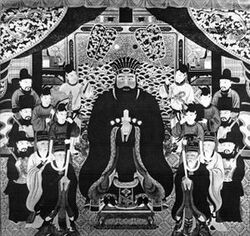- Japanese/Okinawan: 御後絵 (ogoe / ugui)
Ogo-e (lit. "honorable after-portrait") are posthumous portraits painted of each king of the Ryûkyû Kingdom following the king's death.
Documentary sources indicate that ogo-e portraits were produced of each king and crown prince of the Second Shô Dynasty, though it is unclear whether the custom was practiced prior to that. The sources refer to these portraits by a number of names, including ogoei (御後影, posthumous figure), son-i-zô (尊遺像, honored posthumous portrait), and juei (寿影, auspicious figure).[1] Sources suggest they were originally produced and displayed as wall paintings at Engaku-ji, the royal family's bodaiji (family temple), but that in the early 18th century they were remade into hanging scrolls.[2] While originals were held at Engaku-ji, a number of spare or backup copies were held at Shuri castle.[3] As they were lost to deterioration over time, fire, or other incidents, new ones were painted to replace them.[2]
Pre-war writings indicate that the ogo-e were richly colored, painted in mineral pigments on paper. All were long believed lost in the 1945 battle of Okinawa, with eleven surviving only in the form of black-and-white glass-plate photos by Kamakura Yoshitarô, and the rest lost entirely. However, in March 2024, the FBI and Okinawa prefectural government announced that four ogo-e portraits, along with sixteen other artifacts, had been found among the possessions of a Massachusetts family's late relative, and had been returned to Okinawa.[4] These newly-recovered surviving ogo-e will prove an invaluable benefit to efforts already underway for many years to attempt to reconstruct the techniques and reproduce the missing portraits.
The portraits serve as a valuable resource for understanding royal ceremonial garb of the time. They appear to show that royal robes (hibenfuku) grew more elaborate and opulent over time.[5]
The Ogo-e portraits reflect close interconnections and notable distinctions between Ryukyuan painting traditions and those of other East Asian courts. Whereas Japanese portraits typically depict figures seated at a roughly 3/4 angle, facing off to the left or right, Ryukyuan royalty and aristocracy face front in their official portraits. They are also depicted with a group of followers or attendants, and with standing screens, bookshelves, and other accouterments in the background, like Korean kings; Chinese and Japanese portraits, by contrast, typically have minimal or no background, and no secondary figures depicted.[6]
References
- Plaques on display at Shuri castle.[1]
- ↑ These are very rough translations. 「御後絵とは。。。」, gallery label, 返還文化財一般展示会 exhibit, Okinawa Prefectural Museum, 8-10 May 2024.
- ↑ 2.0 2.1 「御後絵とは。。。」, gallery label, 返還文化財一般展示会 exhibit, Okinawa Prefectural Museum, 8-10 May 2024.
- ↑ Hirakawa Nobuyuki 平川信幸, "Ryûkyû kokuô no shôzôga ogoe no kôsatsu: egakareta ishô kara miru kokuô imeeji," de arte 31 (2015), 49.
- ↑ Art Crime Team: FBI Boston Recovers and Returns 22 Historic Artifacts to Okinawa, Japan, FBI website. 15 March 2024.
- ↑ Okinawa bijutsu zenshû 5, 318.
- ↑ Hirakawa Nobuyuki, "Ryûkyû kaiga no rekishi," talk given at Okinawan Art in its Regional Context: Historical Overview and Contemporary Practice symposium, University of East Anglia, Norwich, 10 Oct 2019.
